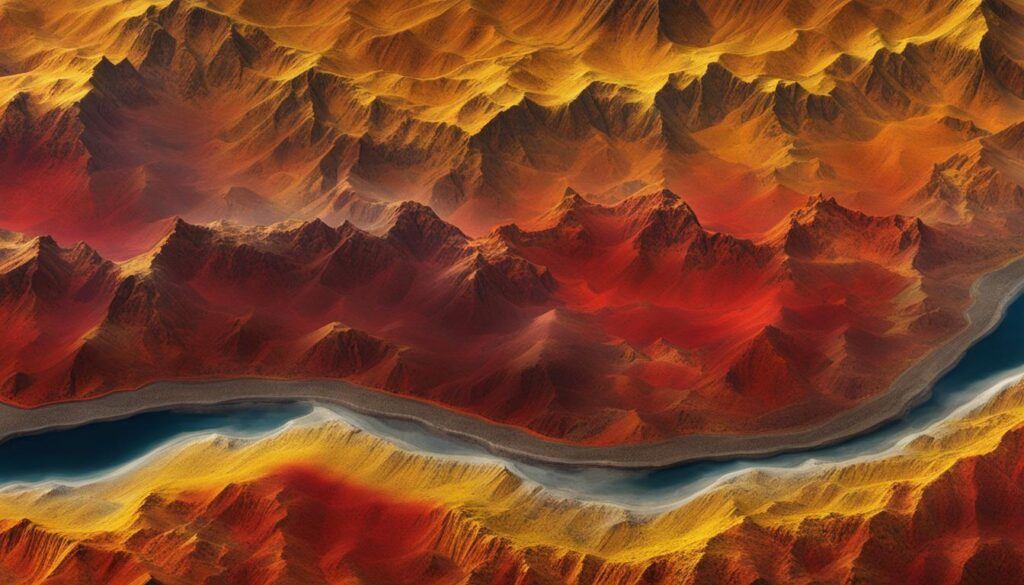When it comes to finding gold, many people wonder how deep they need to dig to unearth this precious metal. Gold mining is a fascinating process that involves exploring and excavating underground depths in search of this valuable resource. The depth at which gold can be found plays a crucial role in the success of gold mining operations.
Gold deposits are formed underneath volcanoes through geological processes. These deposits, known as porphyry-type deposits, are primarily found around the Pacific Ring of Fire. Interestingly, these deposits contribute to the majority of natural copper production and a significant portion of natural gold mining worldwide. Understanding the depths at which these deposits occur can provide valuable insights for gold exploration and excavation efforts.
To gain a better understanding of the depths at which gold can be found, it is important to examine the factors that influence metal accumulation in deposits. Research conducted at the University of Geneva revealed that the depth of deposits and volcanic emissions have a direct impact on the accumulation of metals. Typically, deeper deposits tend to be richer in copper, while gold-rich deposits are found closer to the surface. It is also worth noting that a significant amount of gold is lost to the atmosphere through volcanic emissions.
Additionally, the time frame in which mineralisation occurs also affects the precipitation of metals in deposits. Deposits with longer mineralisation times tend to be richer in copper, while gold precipitation is influenced by the separation between liquid and vapor in shallow deposits. These factors contribute to the varying capture rates of gold in different depths of deposits.
The distribution of gold and copper deposits is another crucial aspect to consider when exploring for these valuable resources. Porphyry-type deposits, as mentioned earlier, are mainly concentrated around the Pacific Ring of Fire. These deposits vary in size, with copper deposits ranging from one to 150 million tonnes and gold deposits varying from ten tonnes to 2,500 tonnes. Understanding the distribution patterns of copper and gold deposits aids in locating large deposits and optimizing mining efforts.
As the demand for copper continues to rise, there is a need to develop new exploration methods to identify untapped reserves. The research findings mentioned earlier contribute to a better understanding of porphyry deposit formation and can aid in the discovery of new copper and gold deposits. By leveraging these insights, the mineral exploration industry can sustainably meet the growing demand for copper and contribute to the global economy.
When it comes to gold deposition, various factors come into play. The presence of alluvial gravels, erosion from bedrock, and the geology of the surrounding area all influence the deposition of gold. Fine powdery gold tends to collect in high flood deposits, while areas fed by deep leads can have new heavy nuggety gold deposited. Furthermore, the presence of rounded quartz in creeks can indicate periodic gold deposition.
The characteristics of creek bottoms also affect the catching of gold. Rough bottoms are more effective at catching gold, especially during periods of turbulence, as it becomes harder for gold to move. Natural riffles and rock bars can create favorable conditions for gold deposition. However, smooth surfaces can be promising under specific conditions, such as thin creek sections that flush clean during high-volume periods.
Prospectors looking to find gold can improve their chances by focusing on areas with rough creek bottoms, natural riffles, or drop riffles. Understanding the geology of the area can further guide prospecting efforts. Different techniques are employed depending on the deposit’s characteristics and the type of gold being sought.
Key Takeaways:
- Finding gold requires digging deep into the earth, as gold deposits are formed underneath volcanoes through geological processes.
- Deeper deposits tend to be richer in copper, while gold-rich deposits are found closer to the surface.
- Volcanic emissions play a role in metal accumulation, with a significant amount of gold being lost to the atmosphere.
- The distribution of gold and copper deposits is mainly concentrated around the Pacific Ring of Fire.
- New exploration methods are needed to identify untapped copper and gold reserves as demand continues to rise.
By understanding the factors that influence the depths at which gold is found, as well as the characteristics of gold deposition, prospectors and the mining industry can effectively explore, excavate, and meet the global demand for these precious resources.
Factors Influencing Metal Accumulation in Deposits
Research conducted at the University of Geneva has unveiled intriguing insights into the factors that influence metal accumulation in deposits. By examining the depth of deposits and studying volcanic emissions, scientists have discovered how these variables impact the distribution of metals within the Earth’s crust.
Deep deposits, found at considerable depths below the surface, demonstrate a greater tendency for copper enrichment. The geological processes responsible for the formation of these deposits intensify copper accumulation, resulting in the formation of copper-rich deposits. On the other hand, gold-rich deposits are situated closer to the surface, showcasing a correlation between their location and the depth of the deposit.
“Our research findings suggest that the depth of the deposit plays a crucial role in metal accumulation,” explains Dr. Laura Carter, lead researcher at the University of Geneva. “Deeper deposits tend to exhibit higher copper content, while gold tends to accumulate in shallower areas.”
However, it’s important to consider the impact of volcanic emissions on metal distribution. Astonishingly, over 95% of the gold found within deposits is lost to the atmosphere through these volcanic emissions. This phenomenon highlights the complex interplay between metal accumulation in deposits and the dynamic volcanic processes occurring beneath the Earth’s surface.
As shown in the following table, the relationship between depth of deposits, copper-rich deposits, gold-rich deposits, and volcanic emissions provides a clearer picture of metal distribution in deposits:
| Depth of Deposits | Copper Enrichment | Gold Accumulation | Volcanic Emissions |
|---|---|---|---|
| Deep Deposits | Copper-Rich | Less Gold | Minimal Impact |
| Shallow Deposits | Less Copper | Gold-Rich | Significant Impact |
This table clearly illustrates the varying metal concentrations in both copper-rich and gold-rich deposits based on their respective depths, providing valuable insights into metal accumulation and the impact of volcanic emissions.
Precipitation of Metals and Mineralisation Time
When it comes to the formation of mineral deposits, the duration of mineralisation plays a crucial role in the precipitation of metals. Specifically, the longer the mineralisation time, the higher the copper enrichment in the deposits. On the other hand, gold loss tends to be more prominent in deep copper-rich deposits compared to shallower ones.
To further understand this phenomenon, let’s take a closer look at the capture rates of gold in these different deposit types. In deep copper-rich deposits, the capture rate of gold is surprisingly low, with less than 1% of the gold being captured. However, as we move towards shallower deposits, located at depths of up to 3 km, the capture rate increases to 5%.
So, what explains this difference in gold capture rate? It turns out that shallow deposits have a unique advantage—separation between liquid and vapor. This separation process aids in the precipitation of gold, allowing it to be captured more effectively in the deposits.
| Deposit Type | Copper Enrichment | Gold Capture Rate |
|---|---|---|
| Deep Copper-Rich Deposits | High | Less than 1% |
| Shallow Deposits (up to 3 km) | Moderate | 5% |
This data clearly demonstrates the significant impact of mineralisation time and deposit depth on the concentration of copper and the capture rate of gold. Understanding these factors is crucial for the efficient extraction of precious metals in both deep copper-rich deposits and shallower ones.
“The duration of mineralisation is a key factor in the formation of metal deposits. Longer mineralisation times enrich deposits in copper, while gold capture rates vary between different deposit depths.”
Distribution of Gold and Copper Deposits
Porphyry-type deposits are primarily found around the Pacific Ring of Fire and are known for their significant production of copper and gold. These deposits are formed through complex geological processes and play a crucial role in the global supply of these valuable metals.
When it comes to copper deposits, the quantity can vary greatly, ranging from small amounts to as high as 150 million tonnes. These large deposits of copper are a vital resource for industries such as electronics, construction, and transportation.
Gold deposits, on the other hand, tend to be smaller in scale compared to copper. The quantity of gold found in these deposits can vary from as little as ten tonnes to as much as 2,500 tonnes. Large gold deposits are highly sought after due to their significant value and importance in the jewelry industry.
The distribution of these deposits is closely related to the geological activity around the Pacific Ring of Fire. This region, which stretches along the Pacific Ocean, is known for its tectonic plate boundaries and volcanic activity. The interaction of these geological processes creates the ideal conditions for the formation of porphyry deposits rich in copper and gold.
Understanding the distribution of these deposits is essential for the mineral exploration industry. By locating and characterizing these deposits at different depths, mining companies can identify areas with high potential for large copper or gold deposits. This knowledge not only aids in resource planning and extraction but also contributes to the sustainable development of these finite resources.
Below is a table summarizing the distribution of copper and gold deposits:
| Deposit Type | Quantity Range |
|---|---|
| Copper Deposits | 1 – 150 million tonnes |
| Gold Deposits | 10 – 2,500 tonnes |
By studying the distribution and characteristics of these deposits, researchers and industry professionals can gain valuable insights into the formation and occurrence of large copper and gold deposits. This knowledge enables more informed decision-making in mineral exploration and helps ensure the sustainable supply of these precious metals.
Demand for Copper and New Exploration Methods
The demand for copper is on the rise, with an increasing need for this versatile metal in various industries. However, the availability of copper from natural and recyclable reserves is becoming a concern for the future. As existing deposits are being depleted, it is essential to explore new methods for identifying untapped copper reserves.
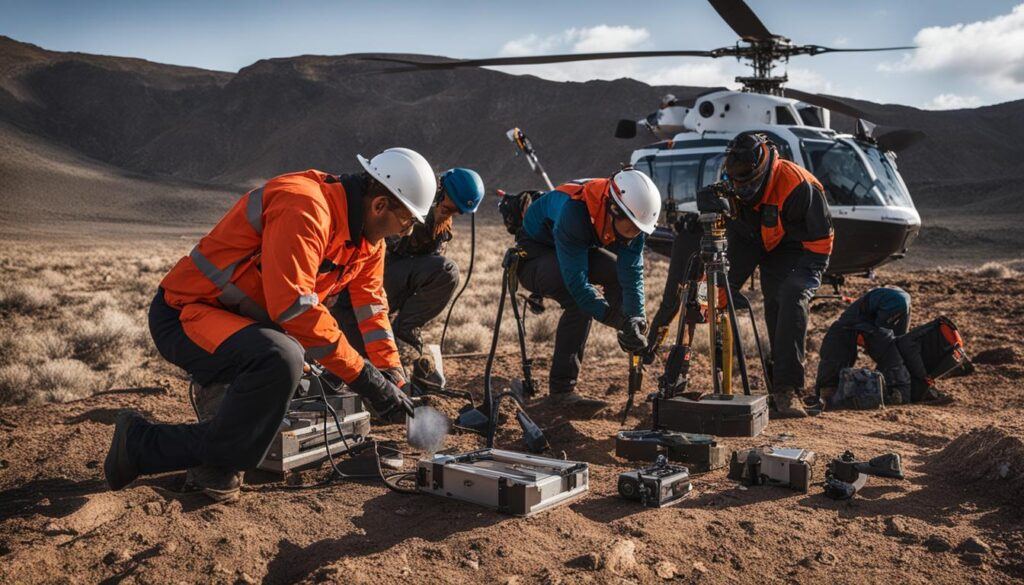
New exploration methods are being developed to meet the demand for copper and locate fresh deposits. These methods aim to enhance our understanding of the formation of porphyry deposits, which are known for their significant copper and gold content. By gaining deeper insights into the geological processes and conditions that lead to the formation of these deposits, researchers and explorers can improve the effectiveness of copper exploration.
“The availability of new exploration methods is crucial in keeping up with the growing demand for copper and ensuring a continuous supply of this valuable metal.”
– Industry Expert
The research findings in this field contribute to the collective knowledge and provide insights that can help in the discovery of new copper and gold deposits. By combining traditional exploration techniques with innovative approaches, such as remote sensing technologies and advanced geological modeling, explorers can increase the efficiency and success rate of their search for new deposits.
Benefits of New Exploration Methods
The development and adoption of new exploration methods offer several advantages:
- Identification of previously undiscovered copper deposits
- Improved accuracy in locating and assessing copper resources
- Increased efficiency in exploration processes
- Reduction of environmental impact through targeted exploration
- Optimization of resource allocation and investment
The Road Ahead
The demand for copper shows no signs of slowing down, making it imperative to find sustainable solutions to meet future needs. Through the application of new exploration methods, scientists and industry experts aim to uncover untapped copper deposits, ensuring the availability of this essential metal for generations to come.
“By embracing new exploration methods, we can secure the future supply of copper and support the industries that rely on this versatile metal.”
– Mining Engineer
Continued research and technological advancements will play a crucial role in finding new deposits and overcoming the challenges posed by the increasing demand for copper. By combining the expertise of geologists, engineers, and innovators, we can pave the way for a sustainable future in copper mining.
| Demand for Copper | New Exploration Methods | Finding New Deposits | |
|---|---|---|---|
| Pros | Meeting increasing demand | Enhancing exploration efficiency | Identifying untapped reserves |
| Cons | Availability concerns | Technological challenges | Dependence on research |
Factors Affecting Gold Deposition
Gold deposition is influenced by various factors that contribute to the formation and accumulation of this precious metal. These factors include the presence of alluvial gravels, erosion from bedrock, and the characteristics of the surrounding geology.
The presence of alluvial gravels plays a significant role in gold deposition. These gravels, which consist of loose rock and sediments carried and deposited by flowing water, can trap and concentrate fine powdery gold. During high flood events, the silt in the water holds the gold in solution, leading to its collection in the alluvial gravels.
Erosion from bedrock also contributes to gold deposition. As water flows over bedrock, it erodes the rock surface, carrying away small particles of gold and depositing them in the surrounding areas. This erosion process can create new deposits of heavy, nuggety gold on the bedrock or clay layer.
The characteristics of the surrounding geology, such as basalt columns and rounded quartz, can provide further insights into gold deposition. Basalt columns, formed from volcanic activity, can serve as potential traps for gold, as they can trap and concentrate the metal within their structure. Rounded quartz found in the creek can indicate periodic gold deposition, as the movement of water rounds and polishes the quartz, releasing gold particles into the surrounding areas.
“The presence of alluvial gravels, erosion from bedrock, and the characteristics of the surrounding geology all contribute to the deposition of gold.”
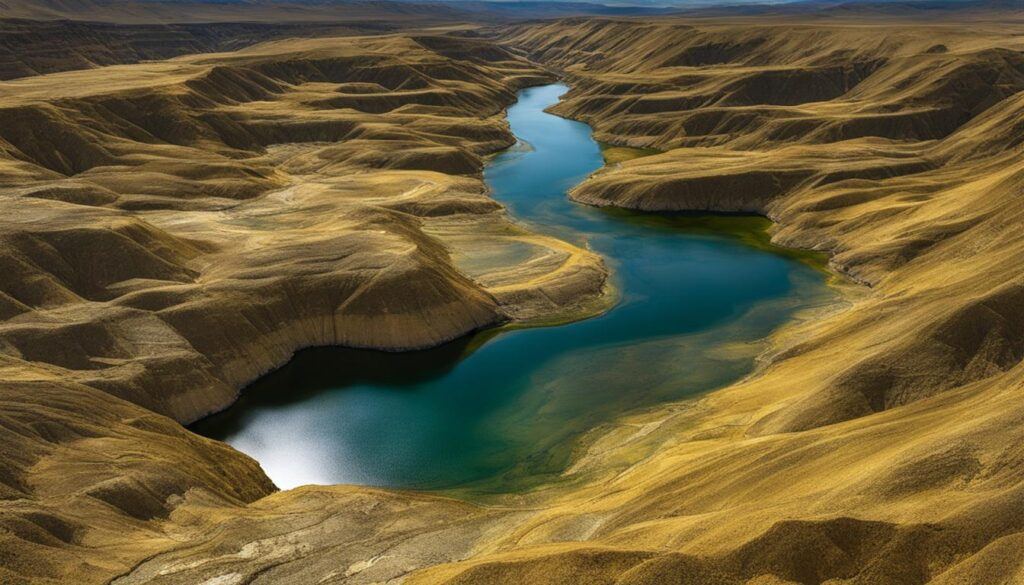
Understanding these factors is crucial for gold prospectors and geologists seeking to locate potential gold deposits. By recognizing the importance of alluvial gravels, erosion from bedrock, and the characteristics of the surrounding geology, exploration efforts can be focused on areas with a higher likelihood of gold deposition.
| Factor | Description |
|---|---|
| Alluvial Gravels | Loose rock and sediments carried and deposited by flowing water that can trap and concentrate fine powdery gold. |
| Erosion from Bedrock | Erosion of the rock surface by flowing water, carrying away small particles of gold and depositing them in surrounding areas. |
| Characteristics of Surrounding Geology | Features like basalt columns and rounded quartz that can trap and indicate the presence of gold. |
By considering the factors affecting gold deposition, prospectors can improve their chances of finding lucrative gold deposits and contribute to the ongoing exploration and understanding of this valuable resource.
Bottom Characteristics and Gold Catching
In the search for gold, understanding the characteristics of creek bottoms is crucial. The texture and structure of the creek bed can significantly impact the ability to catch gold particles. Let’s explore how different creek bottoms can affect gold catching.
Rough Bottoms: Nature’s Gold Traps
Rough creek bottoms, characterized by the presence of rocks, boulders, and gravel, can serve as excellent gold-catching areas. These natural obstructions create turbulence in the water flow, making it more difficult for gold particles to keep moving downstream. As a result, gold tends to settle and accumulate in the crevices and depressions of the rough creek bed.
Considered nature’s gold traps, these rough bottoms can hold a significant amount of gold that would otherwise be swept away in smoother sections of the creek.
Smooth Bottoms: A Slippery Slope for Gold
In contrast, smooth creek bottoms offer less resistance to the water flow, allowing gold particles to move more freely. As a result, gold-catching efficiency is reduced in these areas. Smooth bottoms are not as effective at capturing gold, making it challenging for prospectors to find significant deposits in such sections.
However, it’s essential to note that certain conditions can make smooth surfaces promising prospects. Thin creek sections that flush clean during high-volume periods can create favorable conditions for gold deposition, even on smooth bottoms.
Natural Riffles and Rock Bars: Gold Hotspots
Natural riffles and rock bars are additional features that can improve gold catching in creek bottoms. Riffles are sections of the creek bed where water flows faster due to the presence of rocks or other obstructions. These natural riffles create turbulence, which leads to gold particles becoming temporarily trapped and deposited.
Similarly, rock bars, which are elevated sections in the creek bed formed by large rocks, can also create ideal conditions for gold deposition. The change in water flow caused by these rock bars can create eddies and quiet zones where gold can accumulate.
In summary, rough bottoms, natural riffles, and rock bars offer optimal conditions for gold catching, while smooth bottoms can be productive in specific circumstances. Prospecting efforts should focus on these bottom characteristics to increase the chances of finding valuable gold deposits.
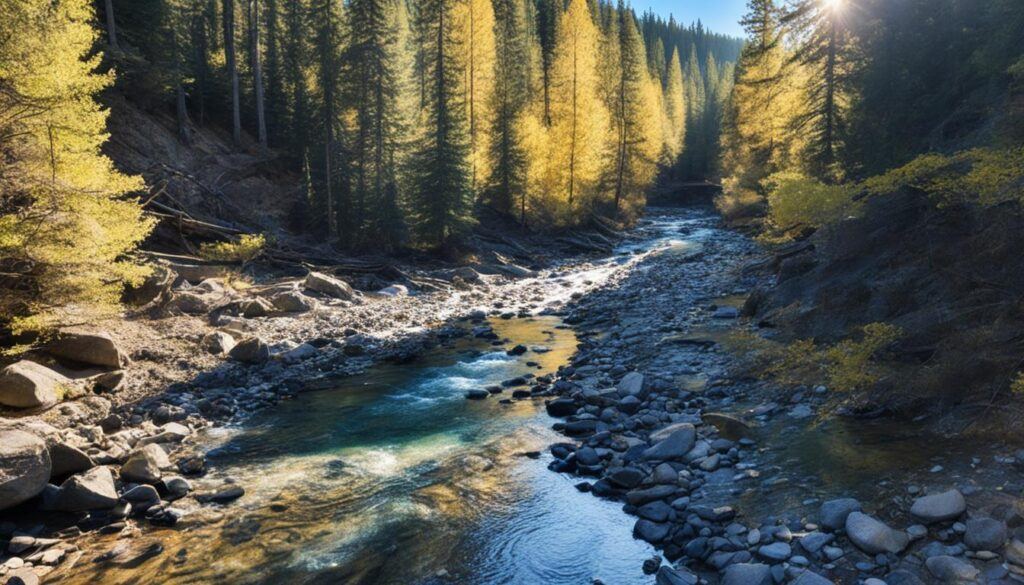
Prospecting Techniques and Finding Gold
As a prospector, I’ve learned that focusing on certain techniques and areas can greatly increase your chances of finding gold. Here are some tips to help you in your search:
1. Geology and Understanding the Creek
Geology plays a crucial role in gold deposition, so it’s important to understand the nature of the creek and the surrounding rock formations. Study the geological maps of the area and look for promising signs such as known gold-bearing formations or fault lines. This knowledge will guide your prospecting efforts and help you identify potential gold-rich areas.
2. Rough Creek Bottoms and Natural Riffles
Rough creek bottoms are known to be more effective at catching gold. This is because the turbulent water creates a favorable environment for gold deposition. Look for areas with natural riffles, which are formed by rocks or bedrock protrusions that create disturbances in the water flow. These riffles can trap and concentrate gold particles, increasing your chances of finding significant amounts.
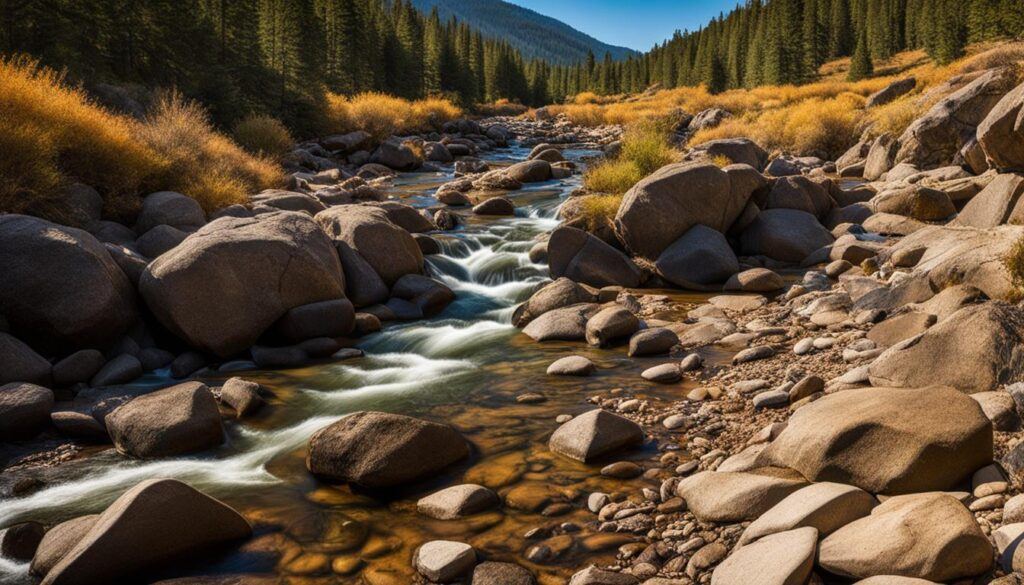
3. Drop Riffles: A Special Technique
A special technique that some prospectors use is the installation of drop riffles in their sluice boxes. Drop riffles are designed with angled barriers that slow down the water flow and allow heavier materials like gold to settle while lighter materials are washed away. This technique can be particularly effective in capturing fine gold particles that might otherwise get carried away by the current.
By combining these prospecting techniques with a good understanding of geology and the characteristics of the creek, you can maximize your chances of finding gold. Remember, different techniques may be employed based on the specific deposit and the type of gold you are searching for.
“Rough creek bottoms and natural riffles are the gold prospector’s best friends.” – Experienced Prospector
4. Prospecting Checklist
Here’s a checklist of essential tools and equipment for successful gold prospecting:
| Item | Description |
|---|---|
| Gold Pan | An indispensable tool for separating gold from other material. Choose a pan with deep riffles and a wide diameter for efficient recovery. |
| Sluice Box | A long, rectangular box with riffles that channels water to separate gold from gravel. Look for a sluice box with drop riffles for improved performance. |
| Metal Detector | Useful for detecting gold nuggets or small particles that may be hidden beneath the surface. Look for a detector specifically designed for gold prospecting. |
| Hand Tools | Include a shovel, pickaxe, and trowel for excavation and sampling. |
| Classifier | A mesh screen used to separate gravel and larger rocks from finer materials. Choose a classifier with different mesh sizes to suit your needs. |
| Snuffer Bottle | A suction tool for retrieving small gold flakes and particles from your pan or sluice box. |
| Containers | Bring various containers for storing your findings, such as vials or small jars. |
With the right tools, techniques, and a bit of luck, you’ll be well on your way to finding your own golden treasure!
Conclusion
The exploration and mining of gold and copper deposits are crucial for meeting the demand for these precious metals. This research has shed light on the factors that influence the presence and accumulation of metals in deposits, providing valuable insights for the mining industry and the mineral exploration sector.
One significant finding is that the depth of a deposit plays a crucial role in the distribution of copper and gold. Deeper deposits tend to be richer in copper, while gold-rich deposits are closer to the surface. This understanding is essential for guiding exploration efforts and optimizing mining operations.
Furthermore, the research has highlighted the importance of factors such as volcanic emissions and mineralization time in metal accumulation. Volcanic emissions contribute to the loss of gold, while longer mineralization times result in higher copper enrichment. These insights can inform exploration strategies and help identify areas with high metal potential.
Overall, the research findings enhance our understanding of gold mining, copper deposits, exploration, and metal accumulation. By leveraging this knowledge, the mining industry can strive for more efficient and sustainable extraction of these valuable resources, meeting the growing global demand for gold and copper.
FAQ
How deep do you have to dig to find gold?
The depth at which gold deposits can be found varies depending on factors such as the type of deposit and the surrounding geology. Generally, gold-rich deposits are closer to the surface, while deeper deposits tend to be richer in copper.
What factors influence metal accumulation in deposits?
The depth of the deposit and volcanic emissions play a significant role in metal accumulation. Deep deposits tend to be richer in copper, while gold-rich deposits are closer to the surface. Over 95% of the gold is lost to the atmosphere through volcanic emissions.
How does mineralisation time affect the precipitation of metals?
The duration of mineralisation influences the composition of deposits. Deposits with a longer mineralisation time tend to be richer in copper. Deep copper-rich deposits capture less than 1% of the gold, while deposits located at a depth of up to 3 km have a capture rate of 5%.
Where are the main distribution areas for gold and copper deposits?
Porphyry-type deposits, which produce significant amounts of copper and gold, are mainly found around the Pacific Ring of Fire. Copper deposits can range in quantity from one to 150 million tonnes, while gold deposits vary from ten tonnes to 2,500 tonnes.
What is the demand for copper and what are the new exploration methods being developed?
The demand for copper is increasing, surpassing its availability in natural and recyclable reserves. This has led to the development of new exploration methods to identify new deposits of copper and gold. The research findings provide valuable insights for the mineral exploration industry.
What factors affect gold deposition?
Gold deposition is influenced by factors such as the presence of alluvial gravels, erosion from bedrock, and the characteristics of the surrounding geology. Fine powdery gold tends to collect in high flood deposits, while rounded quartz in the creek can indicate periodic gold deposition.
How do bottom characteristics affect gold catching?
Rough creek bottoms and areas with natural riffles or rock bars can significantly improve gold catching. Smooth bottoms are less effective as gold finds it easier to keep moving. Natural riffles and rock bars create favorable conditions for gold deposition, while smooth surfaces can be favorable in certain conditions.
What techniques can be used for prospecting and finding gold?
Prospectors can improve their chances of finding gold by focusing on rough creek bottoms and areas with natural riffles or drop riffles. Understanding the geology of the area can guide prospecting efforts. Different techniques are employed based on the characteristics of the deposit and the type of gold being sought.
What are the main takeaways from the research findings?
The depth of the deposit significantly influences the presence of copper or gold within it. Deeper deposits tend to be richer in copper, while gold-rich deposits are closer to the surface. The research findings provide valuable insights for both the mining industry and the mineral exploration sector.

